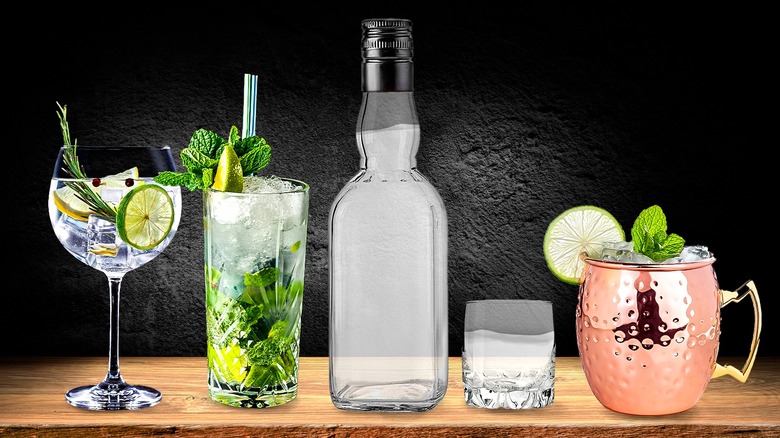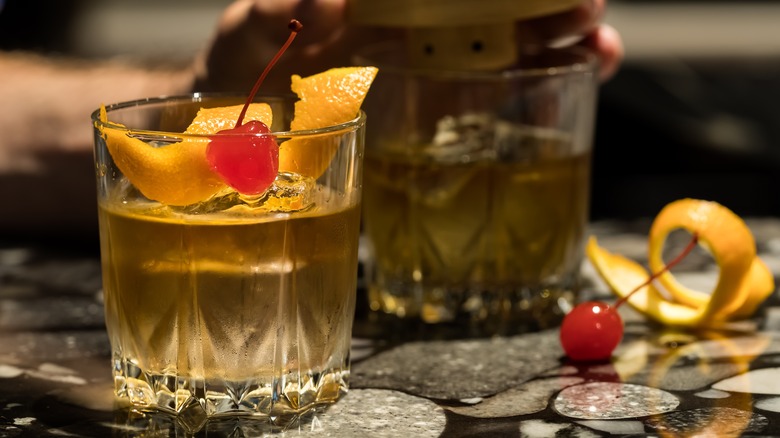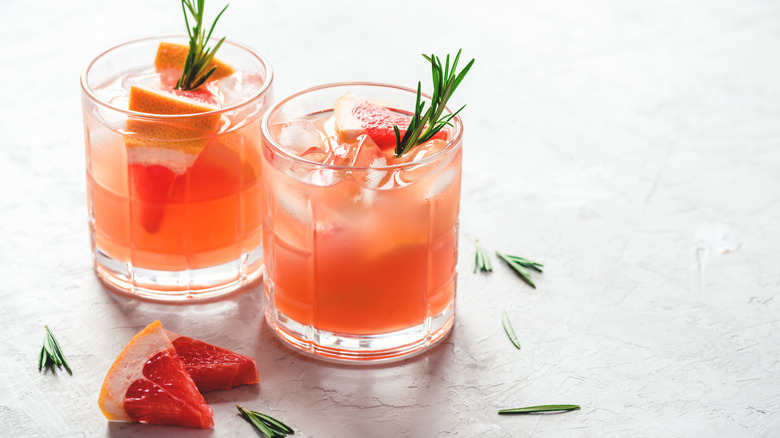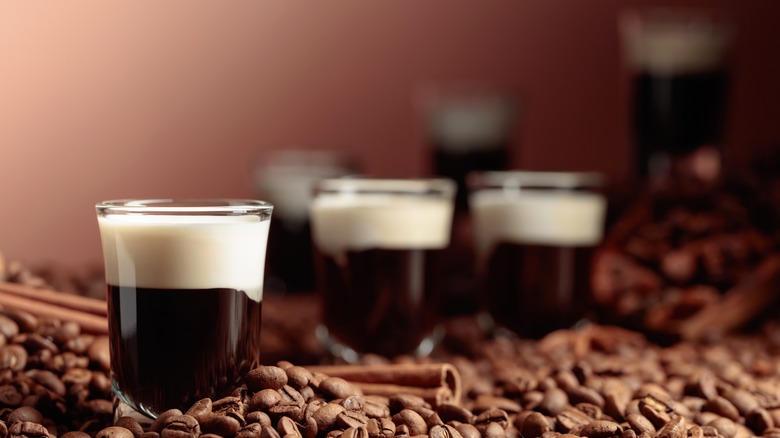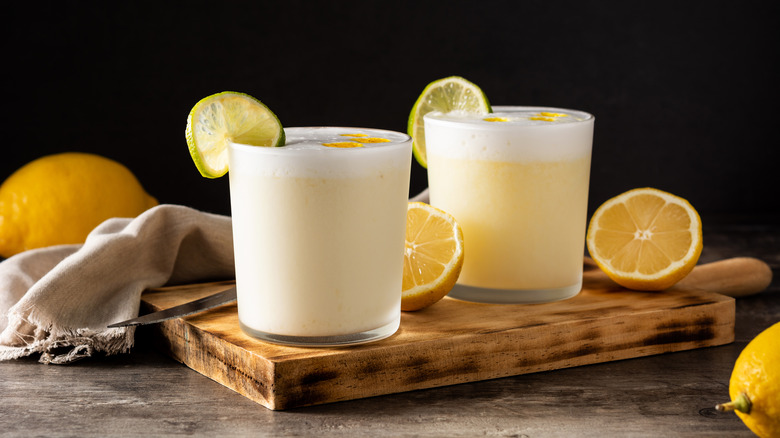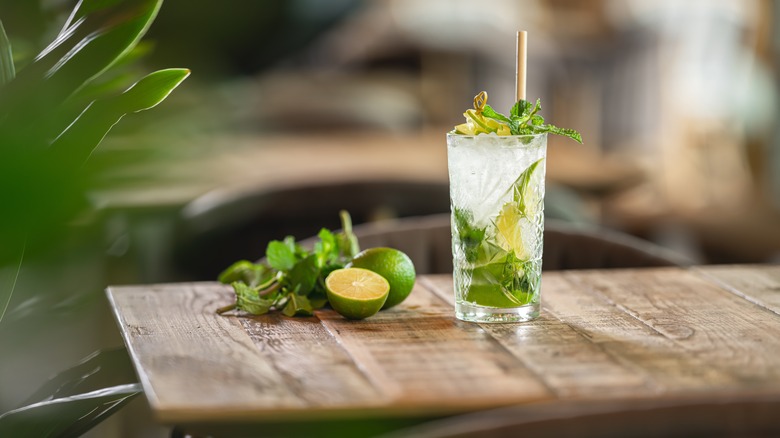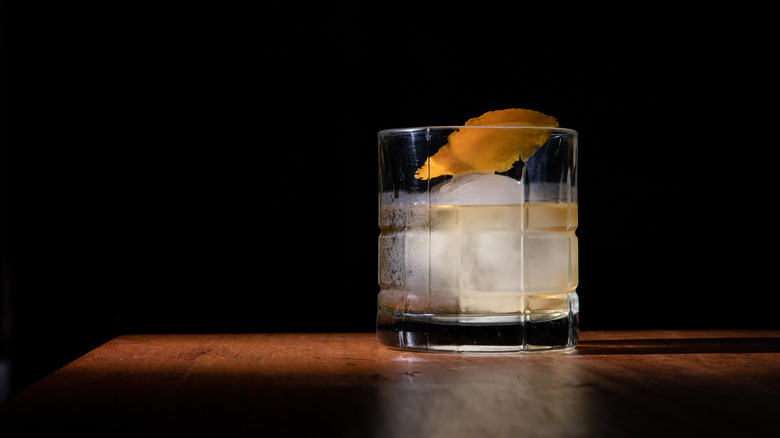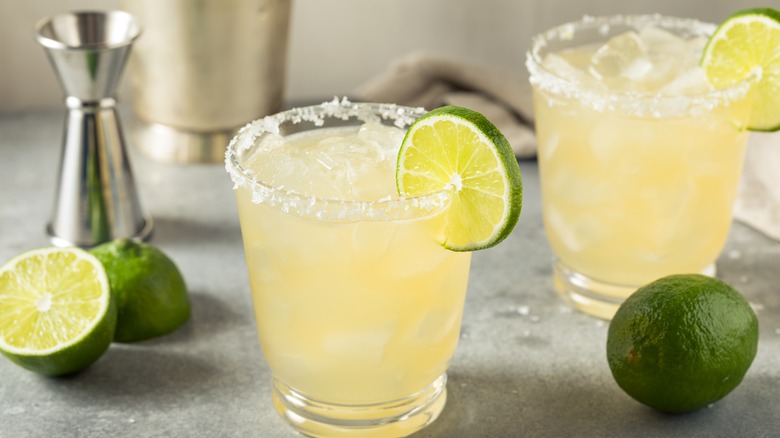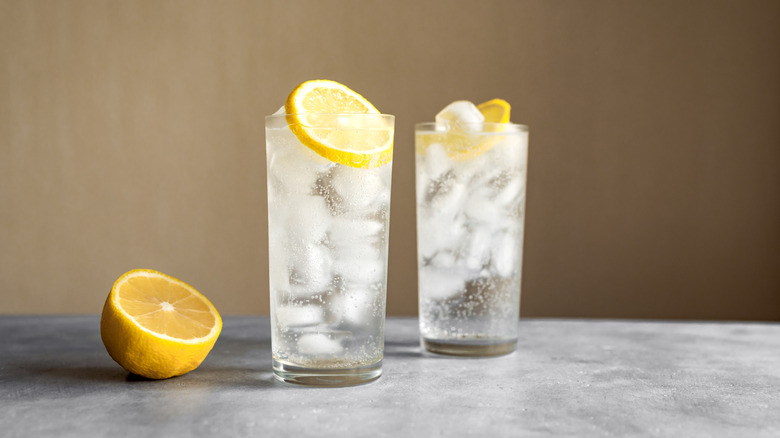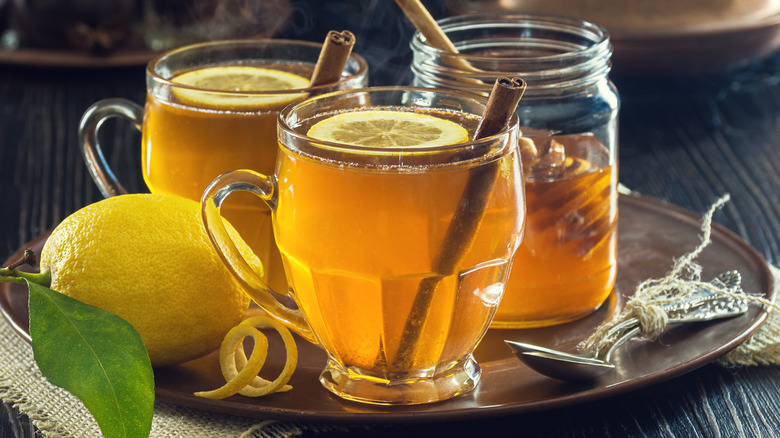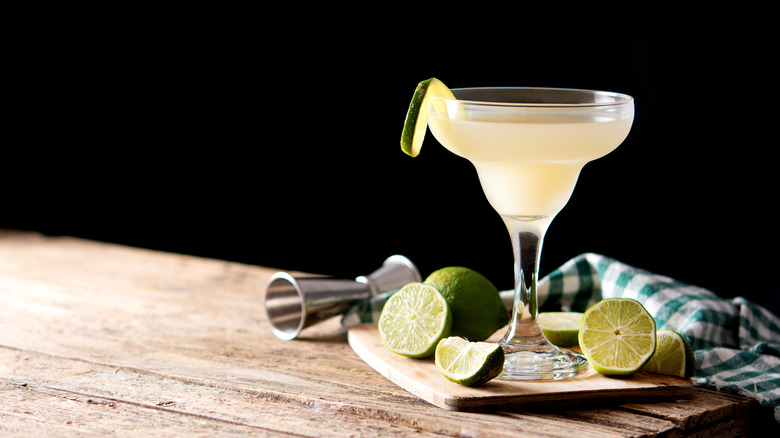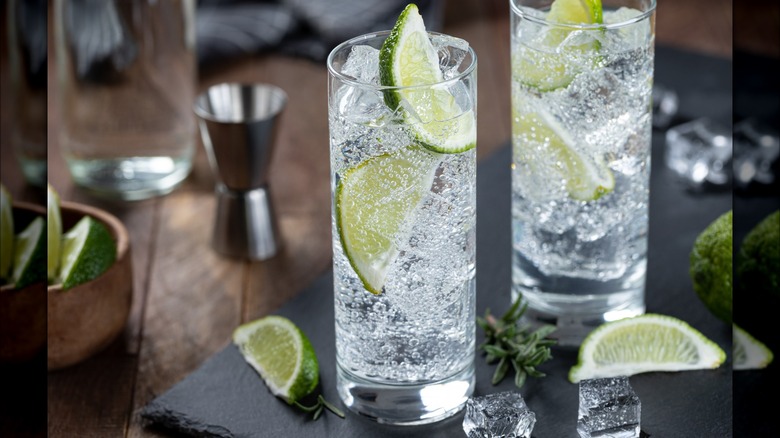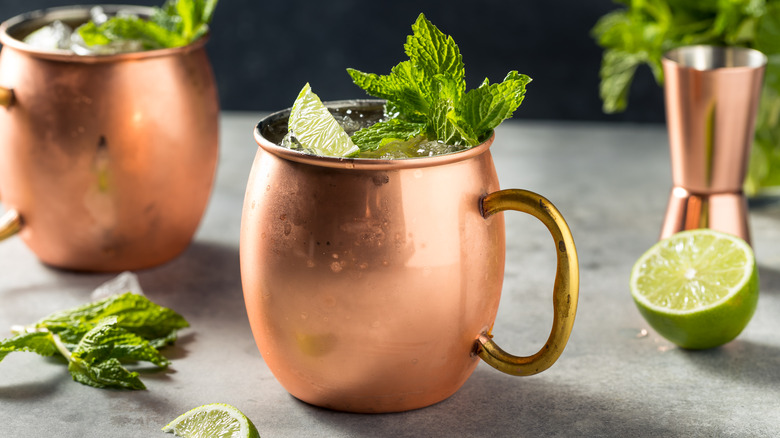12 Drinks To Mix With White Whiskey
White whiskey may seem like an oxymoron to anyone who's only ever known it as a brown spirit. Yet those folks don't realize whiskey is clear before meeting the barrel, where it absorbs the colors and flavors from charred oak while aging. Consequently, white whiskey is usually unaged and spends as little time in oak as possible (the bare minimum required to qualify as whiskey). Now, the effect of wood on whiskey is significant. But many of the flavor notes that make a dram so enjoyable also come from the grains used – which are front and center in white whiskey.
Without the effect of oak aging, white whiskey (sometimes referred to as "white dog") is generally less mellow than its barrel-aged counterpart. Though unfairly compared to moonshine at times, white whiskey adds an intriguing and boozy element to mixers and cocktails. The characteristics of the alcohol's mash bill are still expressed, after all, whether it's spiciness imparted by rye, sweetness from corn, or barley-supplied biscuity cereal notes.
This under-appreciated liquor can be a rewarding substitute for other clear spirits (such as vodka or tequila) when paired with the right mixed drink. Since I've spent the past 10 years pouring, serving, selling, marketing, and educating others about spirits, I'm eminently suited to guide you through your white whiskey experience. To help transform this spirit into the hero of your next cocktail, here are 11 drinks to mix with white whiskey.
White Manhattan
The Manhattan is an all-time classic cocktail (with some evidence suggesting it has existed since the 1860s). Stiff yet elegant, the drink represents a long-popular class of cocktails that combine strong alcohol, sweetness, and bitterness for a palate-satisfying balancing act. Classically, a Manhattan showcases American rye whiskey as its alcoholic lead. But the booziness from white whiskey makes it a great match for a Manhattan in its own right.
For those who confuse the Manhattan with an old fashioned, the sweet difference between these two cocktails comes from the Manhattan's use of sweet vermouth (while its boozy cousin generally includes a sugar cube or syrup instead). Additionally, while an old fashioned usually wears an orange twist, a Manhattan typically flaunts a maraschino or brandied cherry as a garnish. No matter which garnish you choose, you've got some options for introducing white whiskey to this well-established libation.
For a version closer to the original, seek a white whiskey with at least 51% rye (I.E. the usual requirement for a whiskey to be classified as a straight rye whiskey). Of course, white whiskeys that are comprised of other grains — such as wheat, corn, or barley — can add their unique essence to the flavor profile of this highly customizable cocktail, as well. If it tastes a bit too strong, try balancing it with a bit more sweet vermouth or stirring the drink with ice for longer.
White whiskey punch
Whether you know it as a rainbow concoction served in a giant bowl or a finely measured fruity drink, punch is a fun concept. At its core, alcoholic punch generally refers to a mixture of five fundamental ingredients: citrus juice, spirits, sugar, spices, and a diluent (like water). Of course, other ingredients such as tea or additional fruit juices aren't unheard, as the definition is pretty loose. The selection and ratio of ingredients are entirely at the discretion of the drinker, after all, so there's no reason you can't include white whiskey in punch, too.
Interestingly, the history of boozy punch may shine some light on why the drink suits white whiskey so adequately. The classic five-ingredient punch was popular with British colonists in India who sought a way to turn their rougher spirits into something closer to wine for easier drinking. This method effectively helped mask the taste of alcohol – which can be prevalent in white whiskey — which means the unaged whiskey isn't apt to overwhelm the collection of ingredients in your next batch of punch.
Using white whiskey in punch gives it a pleasantly spirited warmth, while its grain base can compliment the fruit, sugar, and additional spices in the mix. Some wheat-based white whiskeys offer honey, vanilla, or mint flavors, and corn whiskey's perceived sweetness is also nicely suited for a fruity punch.
Ozark speedball
A fun relative of The Dude's favorite beverage, the Ozark speedball replaces the vodka found in a white Russian with white whiskey — along with a few additional tweaks. The Ozark speedball integrates equal parts chilled coffee and coffee liqueur alongside white whiskey. Heavy cream is then layered on top to float, while a few dashes of bitters and drops of orange oil contribute an aromatic element. Unsurprisingly, the inclusion of chilled coffee amplifies the coffee flavor, as well, making this drink similar to an Irish coffee (though one with a little extra panache).
One of the great things about this cocktail is that it's quick and simple to make — and requires no particular bartending skills to concoct. The Ozark speedball is credited to House Spirits Distillery in Portland Oregon, which integrated its own White Dog whiskey and coffee liqueur when creating the original drink.
Look for white whiskeys with a predominantly barley base, as they'll bring some pleasant cereal notes to complement the coffee and cream. House Spirits Distillery's White Dog whiskey was made with 100% malted barley., after all, so a barley-centric spirit is ideal for this mixed drink.
White whiskey sour
There are several competing versions of the whiskey sour's origin story. One popular belief states the combination of lemon juice and spirits was an attempt to prolong the life of the scurvy-beating citrus during ocean voyages in the 1800s (or earlier). Another tale contends the addition of liquor simply made the lemon juice more palatable for those seafarers. Either way, with so many different versions of this cocktail existing in the 21st century, why not consider a white whiskey sour?
Part of the appeal of using white whiskey in this mixed drink is the makeup of modern sour cocktails. The use of sugar balances the lemon's intense sourness, creating an enjoyable balance between sweet and sour that helps mask the harshness of whatever spirit is incorporated (as any 19th-century sailor would attest). In other words, the masking effect of this cocktail's sour component is superb at elevating the unaged spirit — allowing white whiskey's flavor characteristics to shine through. Choosing a white whiskey with a wheat base can introduce honey and vanilla to compliment the citrus, although any mash bill should be suitable for this tipple.
Whiskey mojito
The prospect of a frosty mojito on the beach may be more responsible for driving tourism than many people realize. This Cuban invention combines lime, sugar, soda water, white rum, and mint — a five-part combination of ingredients that arguably designates the mojito as a member of the punch family. This mixed drink has earned its reputation as a summery cocktail in its own right, though. And if you'd like to swap out white rum when making mojitos during your next warm weather cookout, white whiskey makes a great substitute.
Now, using the minimally aged whiskey product will likely lead to a slightly dryer style of mojito (given the absence of rum's seemingly sweeter flavor). Still, seeing how the lime, mint, and sugar in a mojito helps with the integration of white rum — which, like white whiskey, is an unaged spirit — the ability to welcome one unaged spirit applies to similar alcohols.
For a closer match to the classic mojito, the perceived sweetness of a corn-based white whiskey can suit the drink in the same way as white rum. Alternatively, the hints of mint that express themselves in a wheat-based spirit can also complement the fresh mint in a mojito.
White old fashioned
The old fashioned is a classic cocktail that epitomizes balance. Where a Manhattan uses sweet vermouth, the old fashioned takes a more straightforward approach with a sugar cube muddled into the bottom of the glass. The drink typically features a boozy dose of bourbon, a little water, a few dashes of bitters, and sweetness to bind it all together — creating a cocktail that's strong yet palate-pleasing. Of course, as you may have guessed, this delicious combination of flavor elements can be altered quite easily by substituting white whiskey for bourbon.
Swapping bourbon with white whiskey offers a departure from the old fashioned's standard texture and flavors (generally honey and vanilla) in exchange for a brighter, more alcohol-forward version. You can stick with a corn-dominant white whiskey for something closer to a traditional old fashioned, or experiment with ones from different mash bills to discover new approaches to the beverage.
Although white whiskey may lack some of bourbon's qualities, its canvas-like versatility creates opportunities for exploration that are limited only by your imagination. One popular riff on a white whiskey old fashioned includes the integration of grapefruit as either a garnish or muddled with sugar (or both) to play off the fruit's bittersweet flavor profile.
White whiskey margarita
The margarita is so well-known as a tequila-based drink that it may seem sacrilegious to replace the spirit with white whiskey. These two alcohols aren't even made from the same mash base, after all, with tequila being a product of fermented agave plants rather than grain. Of course, while unaged tequila and whiskey have undeniably different origins (and flavor profiles), a classic margarita's other ingredients complement white whiskey rather splendidly.
Without the weight and flavor intensity of traditional whiskey, its unaged cousin has refreshment value in a margarita (especially in conjunction with the cocktail's intense citrus sourness). White whiskey can be clean, light, and warming, making it an adept tequila substitute alongside a margarita's lime juice, orange liqueur, and salt rim.
Since the presence of citrus flavor, sourness, and salt help mask hotter alcohol sensations, you can fold white whiskey neatly into a margarita for an unchallenging tipple. Additionally, different brands of this spirit are made with different grains in their base (and contain various flavor notes as a result), so there's no shortage of white whiskeys worth giving a try with this drink.
White whiskey Collins
The Tom Collins is an old-school mixed drink with a mischievous history. Long before white whiskey lovers thought to adopt the clear spirit into the Collins family, this simple drink — a mix of gin, lemon juice, sugar, and soda water (I.E. whiskey's best friends) – had existed in different forms under various names. The John Collins (made with genever) eventually became the Old Tom Collins (which contained old Tom gin), before finally evolving into the Tom Collins. As a mixed drink, the Collins is one of the easiest to make and invites a range of spirits, including white whiskey.
If you enjoy whiskey Collins cocktails, white whiskey suits this tall, thirst-quenching drink as well as any other spirit. As with many other drinks on this list, the use of citrus, sugar, and a dilutant helps make the unaged whiskey much smoother when sipped. Usually served in an appropriately named Collins glass with plenty of ice, this mixed drink is one of the more refreshing ways to enjoy white whiskey.
White whiskey hot toddy
While other cocktails on this list aim to suppress the heat of unaged whiskey, the hot toddy embraces it. Of course, this drink is, quite literally, a hot beverage made with cooking spices, honey, lemon, and spirits. It's a beacon of hope on cold winter nights as a seasonal way to get cozy with whiskey. Spices like cinnamon, cloves, and star anise are common additions (some recipes even call for a touch of tea), though the ingredients of a hot toddy are based entirely on personal preference. In other words, white whiskey can be fairly easily integrated into this cocktail.
What does white whiskey offer the hot toddy? Well, the warmth brought by this spirit is already part of the appeal of a hot toddy; and when combined with lemon and honey, this sensation is more soothing than harsh. Both sweeter-seeming and dryer white whiskeys offer different benefits. Corn or wheat-based white whiskeys can match the sweetness of the honey. Spicy rye-dominant white whiskeys can echo whichever cooking spices are in the drink, while barley-driven spirits offer a bready flavor that goes well in a hot toddy mug.
White whiskey daiquiri
Here's another vacation in a glass that makes white whiskey shine. The daiquiri uses rum, lime juice, and sugar to make a refreshing summertime drink. A classic daiquiri is simple, involving a two-to-one ratio of white rum to lime juice, and just enough sugar syrup to balance the sourness (often just less than the quantity of citrus). Getting the right balance results in a cocktail that's not overly sweet or puckeringly sour, but dry and refreshing.
The combination of sour citrus and sweetness helps soften the edges of harsher spirits like white whiskey — hence the liquor's compatibility with the cocktail. Even if it's not as hard to find smooth and enjoyable rum as it once was, there's magic to be found when mixing this drink with unaged whiskey. When it comes to replacing rum with white whiskey, the key is selecting a spirit that doesn't shift the balance of sweetness too far (as with 100% corn whiskey).
A balance of corn and other grains can help honor the sweetness of white rum without overdoing it or introducing saccharine flavors that might not match the profile of the cocktail. If your whiskey is a tad too sweet, try upping the citrus to maintain balance. Of course, the classic daiquiri is also famous for having some colorful and adventurous siblings, such as the strawberry, banana, and Hemmingway daiquiri. These are excellent opportunities for experimentation with all kinds of white whiskey to find which combinations best satisfy your preferences.
White whiskey and tonic
It doesn't take much imagination or expertise to understand the ingredients of white whiskey and tonic. After all, it's essentially a spin on one of the most popular mixers: the humble yet thirst-quenching gin and tonic. Now, while the gin and tonic was surprisingly invented as a way to whet the whistle of British colonists inhabiting India in the 1800s (simultaneously helping their daily dose of bitter, malaria-combating quinine go down smoothly), gin isn't the only spirit to get the tonic treatment. Whiskey tonics are an enjoyable variation, too, and white whiskey is well-suited for this cocktail.
Now, the lightly sweetened and aromatic but predominantly bitter flavor of tonic is a suitable counterbalance for many aged whiskeys. Of course, without barrel influence, white whiskey may actually have more in common with gin when mixed with tonic (though white whiskey doesn't integrate the flavor of botanicals). Consequently, the brightness of white whiskey and the character of its grain can provide a delicious complement to tonic water's aromatic quality (and its flavor of quinine). More than that, the bitterness of the tonic can help temper the strength of white whiskey when drinking this mixer.
White whiskey mule
One beverage that gives white whiskey's heat a tasty challenge is the Moscow mule — a cocktail that's easily identifiable by its distinctive copper mug. Typically a mix of vodka, ginger beer, and lime juice over ice, this frosty beverage is also garnished with a sprig of mint, a wheel of lime, or both (if you're feeling ostentatious). Popular twists on the drink include the Mexican mule with tequila and the Kentucky mule with bourbon. Of course, the concept of the Kentucky mule also proves the viability of the white whiskey mule.
This mixed drink allows the unaged liquor's grain-driven flavor components to integrate with the strong flavor of ginger and lime. Ginger beer has its own distinctive heat, as well, which can help mask the fire of white whiskey so its other flavors shine. Spicy rye white whiskey nicely complements ginger's bite, while wheat or barley mashes are neutral enough to mimic vodka's understated role in the Moscow mule.
Interestingly, both the origin of the copper mug and credit for this drink's invention are disputed. But regardless of who's responsible for its original creation or first using the cocktail's distinctive serving vessel, the Moscow mule and its whiskey variations have been popular for a long time.
